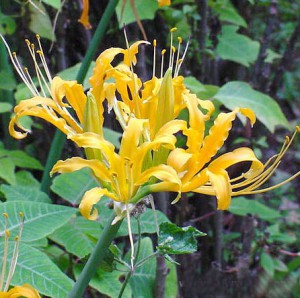Vegetation cycle
In early spring, when the leaves of Likoris begin to germinate, it is at first it can be confused with Narcissus leaves. In June, they begin to turn yellow and die. Among  universal summer flowering beds with lycirides can be "losing" - neither leaflet or flower! But at the beginning of August (in the middle lane, the weeks shifted two weeks) from the soil they begin to "unscrew" the spell-shaped blossoms. Quickly, literally in five days, reaching a height of 40-60 cm, they flourish unexpectedly gentle air flowers with thin long stamens. On one blooming, there are usually 8-10 blast flowers, which also change the color during flowering. If at the very beginning they are a gentle lilac-pink color with a yellow center, then closer to fading become lighter and acquire a blue strip in the center of each petal.
universal summer flowering beds with lycirides can be "losing" - neither leaflet or flower! But at the beginning of August (in the middle lane, the weeks shifted two weeks) from the soil they begin to "unscrew" the spell-shaped blossoms. Quickly, literally in five days, reaching a height of 40-60 cm, they flourish unexpectedly gentle air flowers with thin long stamens. On one blooming, there are usually 8-10 blast flowers, which also change the color during flowering. If at the very beginning they are a gentle lilac-pink color with a yellow center, then closer to fading become lighter and acquire a blue strip in the center of each petal.
Why are seeds not tied?
The thing is that the plant is a cross-permeable, and all numerous copies on the garden, as a rule, are clones of one progenitor. So it turns out that their genotype is the same, and the seeds are not tied.
There are still a suggestion that scientists have a scaly lyciride has a hybrid origin (which is quite often in nature), and therefore the flowers are absolutely all these plants are sterile. Therefore, the method of reproduction of this flower is only vegetative.
Landing and care
The bulb in Likoris is very large (an average of 5 cm in diameter), covered with dark chocolate scales. When landing together with the leaves, it is necessary to keep the initial depth, and the noble lows plant at a depth of no more than 4 cm (from the top). The distance between adjacent bulbs can be 25-30 cm, the plant is necessarily attached every year, and the best (as the experience showed) feels in the group.
The soil should be well drained, heavily better add sand. Location - open sun, permissible slight shading in the afternoon.
In winter, the plant usually does not extortten the beds, it is better not to warm up - it is possible to sing.
Fertilizers can be used any, as for all bulbous. Transfer
Licoris landing time and transplantation - usually immediately after fading leaves or after flowering, but I often had to dig and plant plants in the spring, with a bunch of leaves. There were no special difficulties at the same time, the plant was still ate.
After the transplantation of Likoris necessarily whimshes - blooms for the next year, most likely, will not, and it is also not always possible to count on the third year.













 Start a discussion ...
Start a discussion ...